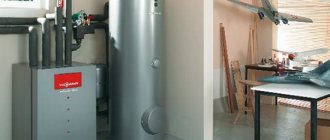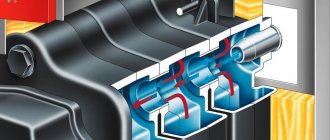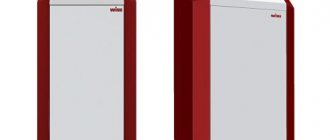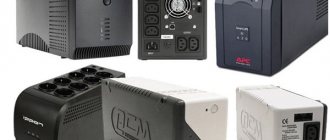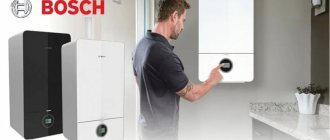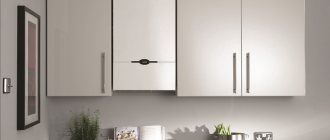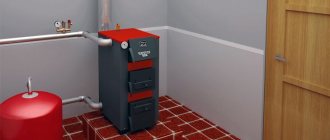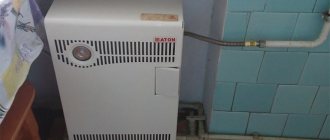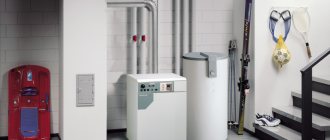Gas-fired heating boilers are devices characterized by increased hazard properties. If such a device is not used correctly, it can cause problems such as:
- spontaneous combustion resulting in fire;
- people can get carbon monoxide poisoning;
- Gas poisoning may occur due to leakage;
- an explosion may also occur.
To prevent such dangerous situations that may result in human casualties, all processes that take place in heating boilers are placed under automatic control. Automation for gas boilers exercises vigilant control to ensure that all systems work clearly and smoothly.
All installations that provide heat to homes and premises and operate on natural gas are certified only if they have a high safety class, and this is achieved only through the use of automation for gas heating boilers.
Design features and advantages
Modifications of the Aton gas boiler are based on the basic version - a boiler with a sectional heat exchanger and an atmospheric burner for gravity-type heating systems with the ability to connect a circulation pump. The boiler design is determined by:
- type of automation;
- rated power;
- executable options.
Heating boiler Aton
Combustion chamber control ensures uninterrupted operation of the burners at a given power level or when switched off. The combustion chamber fittings are equipped with line pressure and combustion pressure connections. The storage product for processed products is connected to a deflector and a smoke exhaust valve.
The heat exchanger insulation is reinforced mineral wool. The generator casing is covered with a wear-resistant coating.
The Aton heating generator is included in the high utility class, in addition, with the following qualities:
- do not require connection to an external power source;
- high-tech burners;
- surfaces are coated with an anti-corrosion compound;
- single-circuit and double-circuit devices;
- original design;
- ease of maintenance;
- efficiency;
- compactness;
- strength;
- accident-free;
- modern design.
Which automation is better: mechanical or electronic?
Devices that control the operation of heating equipment can be mechanical or electronic. In budget models of gas boilers, in most cases, a mechanical, manual control option is used. Despite the fact that the level of technical progress has reached unprecedented heights, mechanics remains a reliable and proven tool. Automated safety systems for gas boilers, operating in manual control mode, are an order of magnitude cheaper. The operating principle of most models of manually controlled boilers is simple and understandable for domestic use.
Regulator of coolant supply intensity to the radiator of a water heating system
The automation unit of the mechanical operating principle is easier to maintain and repair. Disassembling such a unit is quite within the capabilities of a specialist - a heating engineer who carries out a preventive inspection of the boiler equipment in your home.
Manual, mechanical control of a gas boiler is independent of the power supply - the home owner independently sets the temperature required for heating the living space, everything else depends on the laws of physics that form the basis of the mechanism’s operation.
A different principle of operation is inherent in automation with electronic filling, which uses not the physical properties of materials and media, but a fundamentally different method of transmitting a signal to equipment.
Mechanical automation
Manual adjustment of household gas boilers is ensured by the entered settings of a given range of optimal temperature values. Ignition of the combustion chamber flame wick starts the thermostat, which is sensitive to changes in the coolant environment.
Gas boiler burner
The temperature regulator pumps the gas supply to the burner when the water cools in the heating system circuit, and shuts off the flow when it is sufficiently heated. A temperature sensor is installed in the gas pipeline. It is equipped with the following components:
- thermocouple;
- group of levers;
- spring pipe;
- core.
The core is a brass tube and an Invar rod, a sensitive element that responds to changes in the state of the coolant. By changing the length, it opens and closes the valve, adjusting the supply of energy to the combustion chamber of the device.
Electronic automatic control systems
The most common type of automation used in budget boiler models is an electronic thermostat.
The device is installed indoors and controls heating based on signals from an external temperature sensor located in the current zone of the room. When the temperature drops below the set limit, a signal is sent to the boiler to turn on. When optimal temperature parameters are reached, the sensors transmit a shutdown signal to the system. Room thermostats have a cable connection with gas boilers.
In this case, the presence of a thermostat ensures the optimal heating temperature of the gas boiler and economical consumption of blue fuel. Today, there are several types of thermostats on sale, differing in functionality, technical characteristics and installation method. Programmable devices ensure that the optimal temperature regime is maintained inside the living space for a given period of time.
Note: some models can automatically control the operation of a gas boiler during the day, while other models of equipment can control the operating unit during the week. Wireless automatic control devices are also produced that allow remote monitoring of the boiler operation. The range of modern remote control systems, depending on the chosen model, is 25-100 m.
How to choose a UPS?
When choosing a backup uninterruptible power supply for a gas heater, you must take into account the power consumed by the boiler. The more electricity it consumes in the process of heating the coolant, the more capacious the battery is needed. Otherwise, the battery life will be too short. Power outages sometimes last for several hours. If the capacity of the uninterruptible power supply is only enough for a few tens of minutes, then it will be of zero use.
There are three criteria for choosing a UPS for gas heating equipment:
- Water heating boiler power;
- Battery type;
- Operating time from source.
The selected power depends not only on the boiler itself. If the system has a circulation pump and other energy-dependent devices, without which normal heating operation is impossible, then this must be taken into account. Their consumption must also be added to the boiler parameters. Existing do-it-yourself heating schemes for a private house are very diverse; they often contain a huge amount of “smart automation”. However, all these devices consume electricity.
Car batteries cannot be used to provide uninterrupted power supply to a gas boiler. Technically they can be connected. However, they were initially designed for completely different operating conditions. The designers included in them the need for short-term current output when starting the car engine.
If you equip the UPS in question with them, then car batteries will not last long under constant loads. Most of them are simply afraid of deep discharge. Plus, electrolyte evaporation is unacceptable in residential areas.
For gas boilers, you should take batteries made using AGM or GEL technology. In the first, the electrolyte simply does not evaporate due to the solutions used in manufacturing, and in the second, instead of it, a special gel is poured between the battery plates.
To calculate the UPS capacity in a particular case, you should multiply the hours (how long your lights usually turn off) and the boiler power (according to the data sheet), and then divide them by a factor of 8.65. For example, for autonomous operation for 12 hours of a 24 kW heater with an electrical power consumption of 130 W, one 24 V battery or two 12 V batteries are required. C = (150 * 12) / 8.65 = 180 ampere-hour. Most 12 V batteries are usually rated at 100 Ah, so you will need two of them.
When choosing a device for uninterruptible power supply to the boiler, you should also look at:
- The presence of the mark “pure sinus”;
- Charge current parameters (from 4 to 20 A);
- Switching time to battery (0 to 1 second).
The higher the charge current, the faster the battery will be filled with energy. However, charging too quickly is contraindicated for some batteries. If the boiler is equipped with precise electronics, then the transition time from the mains to the battery should be zero. Delays and interruptions in power supply are unacceptable here.
The main point is “pure sine”. If the UPS data sheet states “approximated sinusoid” or “step approximation of a sinusoid,” then such an uninterruptible power supply is intended for computers and televisions. You cannot power a gas boiler from it.
To power both the electric motors of the circulation pumps and the burners, a precisely sinusoidal voltage is required. With a fuzzy sine wave, parasitic currents arise in the electric motor, causing overheating and burnout of the winding insulation. And such a supply voltage is absolutely contraindicated for the ignition electrodes of the burner.
Checking the serviceability and replacing the automation
The periodicity of checking the automation systems of boilers operating on gas fuel is stipulated in SNiP. Maintenance is carried out twice a year during a scheduled inspection, before and after the end of the heating season.
The following signs indicate the need for repair work:
- Increasing frequency of automatic malfunctions of gas-fired boilers. A problem is considered to be a situation in which the boiler turns off on its own every few weeks.
- Spontaneous extinguishing of fire.
- Ignition system failure.
Maintenance and adjustment of the automatic gas heating boiler, in accordance with current rules, is carried out exclusively by qualified personnel who have the appropriate permit and license. Electronic control unit requires installation of special software (firmware).
During the next seasonal inspection, the microprocessor is diagnosed, which is required by the rules for servicing relay automation. Most controllers have a problem diagnostic function installed, a report of which is stored in the device memory. Error information is taken into account when configuring the module.
A complete replacement of the automation is extremely rarely required. In most cases, individual components are changed: thermocouple, valves, sensors, etc.
Why is it beneficial to contact us?
The company's personnel have experience in equipping boiler rooms in residential buildings and industrial enterprises. We will select the appropriate solution for any task. High-quality equipment with proven equipment guarantees timely response of tracking devices to a dangerous signal and prevention of an emergency situation. We offer a range of services: selection of equipment, professional installation, commissioning, subsequent maintenance with performance monitoring. Automatic equipment is individually selected for each object. We guarantee that we will take into account maximum wishes. A range of services is offered at attractive prices. Experience allows us to find profitable solutions for each client. To view the proposed prices and discuss the terms of the contract, call us. Be sure that after concluding the contract, employees will soon cope with the task. Take advantage of the offer today to get the desired result at reasonable costs!
When inspecting boiler room equipment and repairing it, it is necessary to strictly follow safety rules. Our specialists have a high level of professional training and will perform all work at the proper level, minimizing the likelihood of an emergency in the future.
Our dispatchers and emergency teams work around the clock. Dispatchers remotely monitor the condition of objects and, if necessary, send specialists with the necessary equipment for work to the required address
Our experts conduct a comprehensive audit, identifying which factors reduce the efficiency of the facility. The result of their work is a reduction in the consumption of resources for their own needs, increasing the efficiency of the facility, and therefore saving you money
Connecting the Openterm protocol controller
The smooth action controller exchanges an analog signal with the control board. Depending on the rate of heating of the air in the room, it makes adjustments to the temperature supply, reduces the burner power, or, on the contrary, increases it if the temperature is too low.
Another additional feature is that when exchanging data with the boiler control system, a blocking indication can be seen on this controller. That is, if the boiler stops, you can see this without going to the boiler itself, but directly on the display of the sensor located in the room.
+ The device automatically adjusts the heater power based on a number of parameters.
— Quite a high price.
Types of remote heating control systems
In addition to the presented remote boiler control systems - using the Internet and using cellular communications, there is a third type, which is called combined. In this case, remote control of the heating boiler can be carried out in any convenient way, either using the Internet or using a mobile phone.
The following operating modes are provided for this system:
- Automatic - here the gsm controller for the heating boiler executes a number of specific programs, processing information received from external sources.
- SMS - operates by transmitting the parameters of the temperature sensor to the phone in the form of SMS messages, in this case the controller for the boiler configures the heating system using the input data.
- Warning – sends alarming SMS when critical situations arise.
- Provider - carries out remote coordination of related devices, such as heating elements for heating water, a thermostat for electric heaters, an electric boiler control unit or a gas boiler control board.
The equipment for the presented remote monitoring system has the highest cost. However, in this case, remote control can be carried out in any convenient way and from any location.
According to the method of exhaust gas emission
Based on how the smoke is released, the following types of boilers are distinguished:
- Chimneys.
- Turbocharged.
- Parapet.
The first type is boilers with an open combustion chamber. As the name suggests, they require the installation of a high-quality chimney.
Scheme of a turbocharged double-circuit gas boiler
Turbocharged boilers have a closed combustion chamber, and the gases are forced out by a built-in fan. Such devices need a coaxial pipe (essentially, these are two pipes one in one: smoke comes out through the inner pipe, and oxygen necessary for the combustion process enters through the outer pipe). Pipes are laid through external walls without installing a vertical channel.
Parapet. The boilers are similar to the previous version (also has a closed combustion chamber and a double pipe), but smoke is removed due to natural air circulation, and not by a fan. Therefore, parapet boilers do not require electricity.
By material and type of heat exchanger
Heat exchangers can be:
- cast iron;
- copper;
- aluminum-silicon;
- made of carbon or stainless steel.
The design of the heat exchanger may also vary.
The most popular are separate heat exchangers. Heating water flows separately, and water for residents’ household needs passes separately. They are a little more expensive, but more reliable.
A bithermic heat exchanger looks like a pipe within a pipe. In the inner pipe there is DHW water, which needs to be heated, and in the outer pipe the heating coolant circulates.
The third type is a heat exchanger in which a coil is built in. The container with water is heated by the coolant flowing in the coil. An indirect heating system is good for everyone, but in the summer you will either have to heat the boiler or live without hot water.
The bithermic option is not recommended for use where there is hard water. And be prepared that every time scalding water will flow out of the tap first, and only then at the temperature you need.
Mechanical
Mechanical automation for gas boilers does not require connection to the electrical network. This is the main advantage. However, it is not always completely mechanical. It can use a built-in power source - a battery or an accumulator - and use other sources, such as a thermocouple, which produces an emf when exposed to high temperatures. Energy independence still remains, which is ultimately what is required. All settings are set manually, and with a significant error.
At the moment, one automatic control system has become widespread - EuroSit 630. This automation unit with Italian roots turned out to be so good and practical that it is installed on almost all gas boilers with non-volatile control. It is produced in many countries with or without a license.
Automation unit EuroSit 630
The mechanical automation unit is a metal case with a labyrinth inside through which gas can pass from inlet to outlet. A number of valves regulate gas supply, pressure and flow depending on operating conditions and settings. Two control knobs set the boiler operating mode and the target coolant temperature setting.
The main handle defines three operating modes:
- complete shutdown;
- lighting the fuse;
- main combustion mode.
In the first mode, the gas supply is completely stopped.
In the second mode, only the igniter operates. This is a small burner with minimal gas consumption, which burns constantly and is needed to ignite the gas in the main burners of the combustion chamber. By pressing the switch handle, the damper on the gas path to the igniter opens. The igniter is ignited using the piezo ignition button. A temperature sensor or thermocouple is attached next to it. Under the influence of high temperature, an EMF of approximately 25 mV is generated on the sensor, which is enough to power an electromagnetic relay that keeps the damper constantly open. When the thermocouple warms up well, release the handle and the igniter will not go out. If for some reason it goes out, the thermocouple will cool down and the relay will close the valve again.
In the main combustion mode, the automation opens the flow for the bulk of the gas on its way to the burners. The gas ignites from the igniter, the heat rises to the heat exchanger and is transferred to the coolant.
The valve responsible for the gas supply is connected to a temperature sensor, which is attached to the outlet of the heat exchanger. A sensor is a vessel filled with a liquid or gas that can expand or contract greatly when the temperature changes. The vessel is connected via a thin copper tube to the automation unit and exerts pressure on the valve stem.
The adjustment knob sets the valve response thresholds depending on the pressure exerted by the sensor. If the coolant temperature is lower than that set by the regulator, then gas supply is allowed. When the maximum permissible temperature is reached, the gas supply stops.
Another temperature sensor is installed before exiting the chimney. It reacts to the temperature of the exhaust gases. If they are too cold, it means there is no draft, or the burner is not working, there is no fire. In any case, this is a signal to shut off the gas. If the temperature of the exhaust gases is too high, it means that combustion is maintained too intensely, which should also be stopped.
A number of adjustment bolts, not accessible to the user during normal operation, allow you to:
- set the permissible gas flow and pressure;
- set the minimum gas pressure;
- adjust the limits of temperature change of the coolant.
Their installation should be carried out by a specialist during installation and initial setup of the gas boiler.
A common problem with non-volatile automation is the incorrect operation of temperature-sensitive elements. The thermocouple on the igniter is difficult to produce, and the output characteristics of each sensor vary greatly even within the same batch, which gives a significant error in the operation of gas boilers. The situation is simplified by the fact that even a non-specialist can replace a thermostat or thermocouple; they are commercially available and are often interchangeable.
What automatic settings are there?
Currently, the market offers consumers a wide selection of control devices. Therefore, you need to know what automation systems for home heating systems generally exist, and what to give preference to.
Room thermostat
According to installation criteria, there are:
- Wired thermostats. The advantage of this type is the ability to supply power up to approximately 50 meters via wires.
- Wireless thermostats. The advantage is that it is not necessary to create holes for the wires. However, they have a significant drawback - reinforced concrete walls reduce the signal power.
According to functionality they are distinguished:
- Simple thermostats. They retain the desired level of warmth.
- Programmable thermostats. Such devices are capable of setting a certain number of degrees for a whole week in advance (the period depends on the model) with maximum accuracy down to seconds. The advantages also include cost savings due to weekly programming.
Thermostats are also distinguished:
- Electronic thermostats. The kit contains three components: temperature sensor, signal transmitter, relay. The main advantage of the device is the maximum accuracy of the equipment. Don't forget ease of use.
- Mechanical thermostats. The basis of the devices is the ability to change properties under the influence of temperature levels. Due to temperature changes in the gas membrane, a circuit is closed or opened, causing certain mechanisms to work.
- Electromechanical thermostats. The mechanism of the device is much simpler than an electronic one. The main element is the relay. The node looks like a tube, which is filled with a special substance that reacts to temperature. If the boiler heats up, the substance expands; similarly, when the boiler cools, the substance contracts. And the drive, dependent on the substance, regulates the temperature thanks to an electrical circuit.
Connection can be made to:
- Kotlu;
- To the pump;
- Servo drive;
Thermal head
This is a thermostatic element that, under the influence of the external environment, slightly opens or closes the radiator. An inexpensive type of automation for heating a home. A significant advantage is that the thermal head is very convenient for local heating, and there are also significant cost savings. Of the minuses: firstly, the adjustment occurs according to standards consisting of abstract numbers, not degrees. Secondly, the sensor measures the degree of heat around the installation, but not the room, which reduces the accuracy of the device.
Weather-compensated automation
The design of weather-dependent automation for heating a house is simple: as the weather outside decreases, the temperature of the coolant increases. However, a weather-dependent installation has a very significant drawback - the system sometimes does not have time to adapt to the temperature, and, therefore, the effect is delayed. The especially mentioned disadvantage manifests itself if an addition is connected - heated floors. The disadvantages include the fact that the devices do not operate entirely correctly, approximately, so the change is noticeable only during seasonal climate changes. It is worth noting that the prices for the unit are relatively high. But the units will be very convenient in production, large-scale houses (over 500 square meters).
Description of non-volatile units
Such automation modules installed on gas boilers are much simpler in design, but poorer in capabilities. They are equipped with budget models of boilers with a power of up to 30 kW.
The operating principle of the control unit for such installations is mechanical; adjustment is carried out manually by turning the knob. The device will work reliably in the absence of electricity. On the handle or on the body around it there is a scale with some conditional power levels from 0 to, for example, 6 or 10. The user manual describes approximately what level of hot water consumption from the hot water supply system this or that value corresponds to
The mechanical thermostat opens the gas supply valve and keeps it open until the set temperature is reached. The automation of the gas unit is equipped with draft and flame sensors. When the draft in the chimney stops, the fuel supply is instantly shut off, eliminating leakage.
The flame in old-style boilers had to be lit manually. Modern models are equipped with a piezoelectric ignition device.
Italian automation for boilers produced by EuroSIT is popular among manufacturers. It is distinguished by well-thought-out design and high reliability. The presence of a EuroSIT valve is a strong argument in favor of purchasing a specific model.
In general, a non-volatile module is characterized by simplicity of design, high reliability, low price, limited functionality
The most common breakdowns in the control unit
Since the control unit is a whole system, a failure can occur from any deviation of a component of this system. The most common malfunctions and their causes:
- the burner went out - air got into the gas pipeline;
- heating problems - poor gas supply, lack of oxygen;
- boiler overheating - closed contacts, prolonged operation at high temperatures, factory defective sensors;
- breakdown of the pneumatic relay (draft sensor) - incorrect connection, fan breakdown, incorrect smoke exhaust system;
- breakdown of the temperature sensor - incorrect connection of contacts, short circuit, overheating of the board;
- breakdown of the pressure switch - low water pressure in the pipes, defective contacts in the circuit board.
Most of these problems are easily fixed, even described in the instructions, but some require the intervention of a specialist.
You should not replace sensors or other parts yourself - this can be dangerous.
Connecting the thermostat
When connecting a conventional thermostat to the boiler (as an element of automation), operating comfort increases and gas consumption is reduced. This occurs due to the fact that the boiler is controlled by a sensor installed in the thermostat itself and turns off the burner when the set air temperature is reached in the room.
Taking into account the fact that the volume of air in the room is several times (or even tens of times) greater than the volume of the coolant, its cooling rate is several times lower than the rate of temperature drop in the boiler.
However, in this operating mode it is impossible to adjust the coolant temperature using the thermostat itself. Therefore, the value on the boiler is most often set to the calculated maximum. This is done to ensure that the boiler reaches the set temperature as quickly as possible. However, this method has one negative side. The media temperature either rises to maximum or drops almost to room temperature during idle time. During the off-season, this can lead to uncomfortable sensations. The radiator is either cold or hot - this is not very convenient.
Weekly programmer
More advanced device. It has broader functions and capabilities for controlling the indoor climate. You can choose either a preset mode or customize it yourself. The cycle is set for a week and, accordingly, is repeated weekly. The most commonly used connection is via a radio channel.
The devices vary in design and color, so you can choose a programmer to suit your taste and interior, which is also a small but pleasant plus.
Use of multiblock automation for gas boilers
Companies specializing in the production of gas automatic systems - SIT, Dungs, Honneywell - offer consumers ready-made units, which are a set of devices. It includes filters, valves, a temperature regulator, and a pressure stabilizer.
The ELLETROSIT automation system consists of:
- combined gas valve;
- limit thermostat with sensor;
- adjustable thermostat with temperature sensor;
- traction sensor;
- gas fuel pressure stabilizer;
- two-stage main burner valve.
The stop valve is turned on and off by a thermostat that controls the temperature of the coolant in the heating circuit.
Attention! This system provides the ability to connect a room thermostat, which automatically ensures the set temperature in the heated room
The functions of modern automatic control systems have long been not limited to monitoring the start and stop of the boiler, but also effectively provide diagnostics, alarms and power control of the heating installation.
Automation Vaillant
"Forewarned is forearmed!"
A boiler control system in its most general form is a systematized set of means of influencing a controlled object in order to achieve certain goals by this object.
In our case, the “controlled object” is a boiler, burner, pumps, pipelines, a boiler for preparing hot water, radiators, “warm floors”, etc. that is, the heating system as a whole. The “goal of control” is, on the one hand, to maintain the set temperature in the house, obtain a sufficient amount of hot water, that is, to create conditions for the most comfortable living, and on the other hand, to reduce energy costs and extend the service life of equipment.
I would like to note right away that comfort and economy are incompatible concepts, but boiler room automation allows them to be combined. furnace, individual heating points. What is automation of boilers and heating systems? First of all, let’s focus on boiler automation itself. The mandatory set includes protection and control organs.
Boiler safety automation must include an overheating protection thermostat. Also optionally installed are relays for protection against a decrease or increase in coolant pressure, devices for monitoring the fullness of the boiler block with coolant, a gas pressure control relay (if the boiler is gas), on atmospheric gas boilers it would not be superfluous to install a flue gas monitoring relay, also known as a reverse sensor traction. All these elements are designed to prevent the operation of boiler equipment in unacceptable modes, both from the point of view of the safety of the heating system and the safety of the owner of the house, cottage, cottage, and company personnel.
Basic automatic control, as a rule, consists of one single control thermostat, which sets the maximum boiler water temperature. Plus an on/off button, a pressure gauge and a thermometer. All! But there are people who sincerely believe that this is enough. There are two options here: for comfortable use of hot water, the boiler constantly operates at maximum temperature and you have to open the windows in the house (the so-called “window control”, in Germany they just don’t shoot for this), which, among other things, increases bills for gas, diesel fuel, firewood, coal or, in order to save money, set the thermostat to minimum, “driving” the boiler into condensation mode of operation, thereby hastening its quick death from corrosion. The funniest and saddest thing about this is that the fuel economy is miserable. It turns out that with completely manual control, in most cases neither comfort nor efficiency is achieved.
Varieties
All equipment of an automatic gas water heater that controls the heating system modes can generally be divided into two main components. Moreover, the first group includes safety devices that are capable of maintaining the operation of the AGV in a given temperature range and ensuring the reliability of the system.
The second group includes automatic safety devices designed to ensure the most comfortable operation of the units. For example, a built-in electric ignition or an electronic thermometer is used for this purpose.
The mandatory list of safety automation systems used for gas boilers includes a regulated group of elements.
- A unit that controls the pilot flame. It should include automatic elements for gas units that have the ability to independently stop the gas supply.
- A unit that controls heating parameters of the coolant, capable of stopping heating when the maximum permissible level is reached.
- A module that controls draft, capable of interrupting the gas supply to the operating burner in the event of violations of the exhaust outlet.
- A safety valve that allows the release of excess pressure in the coolant.
If all the specified elements are present that ensure adjustment of the equipment of the existing gas boiler, the existing heating system is recognized as suitable for safe use and is allowed to operate. An entry about this is made in the automatic safety log of the water heating boiler.
Protective automation
Automation units from the first group, as its name suggests, are designed to protect the boiler and the room in which it is installed. These devices stop the gas supply in the event of an emergency.
Gas control
This is usually understood as “monitoring the presence of a flame” of the burner. When the burner goes out, the gas supply must be stopped. This is a basic protection function that is present in all boilers.
This automation module consists of two units: a gas supply valve and a thermocouple (Fig. 1).
Rice. 1 Thermocouple and solenoid valve
Thermocouple is a passive temperature sensor, i.e. does not require external power. It consists of two soldered conductors made of different metals (Fig. 2.). When the soldering point is heated, a thermo-emf is induced in the conductors; in other words, a small voltage arises, sufficient to open the gas supply electromagnetic valve.
Rice. 2 Operating principle of a thermocouple
That is why, when starting the boiler for the first time, you need to hold the ignition button for several seconds - the time during which the thermocouple will have time to heat up and sufficient voltage will arise on it to maintain the gas valve in the open position.
Do not be confused: in the description of the boiler, this automation unit is usually called “gas control”, however, it would be more correct to call this function “flame presence control”, because Other automation components, which we will consider later, can also turn off the gas supply in an emergency.
Boiler thermostat
Thermostat is a device necessary to maintain the set temperature of the coolant. It turns off the boiler when the set temperature is reached and turns on when the temperature drops below the set threshold. The thermostat handle has several modes, each mode corresponds to its own coolant temperature.
Rice. 3 Thermostat
If the boiler is electronically controlled, the temperature can be set using the user terminal and shown on the display.
The thermostat can be considered a device that regulates the operation of the boiler, but it also performs protective functions: protection against overheating and freezing. This is achieved by having the thermostat have upper and lower threshold values. When the coolant temperature reaches the upper emergency threshold, the boiler turns off to avoid overheating. When the lower emergency threshold is reached, the boiler turns on at maximum power to prevent the coolant from freezing.
It is worth keeping in mind that if “thermostat” is written in the list of technical characteristics of the boiler, this means the presence of a control thermostat. The overheating protection function is present in any boiler, even if it is not specifically indicated. But frost protection is present only in those boilers where this function is specified in the characteristics.
Traction control
The draft intensity must be sufficient to completely remove combustion products from the room in which the boiler is installed. If there is insufficient draft, combustion products accumulate inside the room, which is dangerous to human health. When the draft control sensor (Fig. 4) is triggered, a control signal is generated to stop the gas supply and turn off the boiler.
Figure 4. Traction control sensor
When installing a heating system, the draft is checked by a technician, but the draft may deteriorate during operation for many reasons (contamination of the exhaust pipe, etc.)
Therefore, draft sensors are an important component of the boiler safety system
Safety valve
Rice. 5 Safety valve
It is necessary to discharge excess coolant from the system when its pressure increases above the permissible limit. This situation is possible with a sharp increase in the temperature of the water (coolant) in the system. This can lead to damage to the boiler and other components of the heating system. Therefore, it is better to purchase a boiler with a built-in safety valve or install it separately.
Automatic air vent
When a heating system is put into operation, air inevitably gets into it, which can be quite difficult to get rid of. In addition, air can accumulate in the system during operation. It interferes with the normal operation of the heating system, creates noise and bubbling in the pipes. The air vent (Fig. 6) automatically releases all the air accumulated in the heating pipes. It cannot be called a mandatory node, but its presence in the system greatly simplifies the user’s life. Therefore, the best solution would be to choose a boiler with a built-in air vent.
Rice. 6 Air vent
(no votes yet)
How does draft type affect boiler operation?
Devices operating on natural draft are called atmospheric. To burn the gas, they take oxygen from the room in which they are located. The release of waste substances occurs through the chimney; from the outside it looks like a chimney. Natural draft boilers have the following advantages:
- simplicity of design;
- quiet operation;
- relatively low price;
- autonomy - they do not depend on electricity.
Chimney of a gas floor-standing boiler Among the disadvantages, one should keep in mind the unstable operation of the device when the pressure in the gas lines changes. If it decreases, the flame may go out. In such conditions, “blue fuel” is consumed very uneconomically. Those who install forced draft boilers do not face this problem. Other advantages of such units include the fact that they:
- do not burn oxygen in the room;
- do not require installation of a vertical chimney;
- can be placed in almost any home.
Operation of a boiler without a chimney Devices that operate on forced draft are called fan or forced draft. Their operation requires the installation of a coaxial chimney. Oxygen is supplied through it for the combustion of “blue fuel”, and substances formed as a result of the operation of the boiler are removed. All this happens with the participation of fans. They perform their functions by making noise, which can cause inconvenience to residents. Other disadvantages of forced draft units are their high cost and dependence on electricity.
